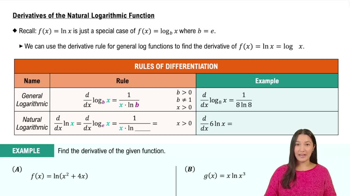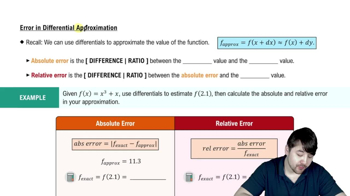Table of contents
- 0. Functions7h 52m
- Introduction to Functions16m
- Piecewise Functions10m
- Properties of Functions9m
- Common Functions1h 8m
- Transformations5m
- Combining Functions27m
- Exponent rules32m
- Exponential Functions28m
- Logarithmic Functions24m
- Properties of Logarithms34m
- Exponential & Logarithmic Equations35m
- Introduction to Trigonometric Functions38m
- Graphs of Trigonometric Functions44m
- Trigonometric Identities47m
- Inverse Trigonometric Functions48m
- 1. Limits and Continuity2h 2m
- 2. Intro to Derivatives1h 33m
- 3. Techniques of Differentiation3h 18m
- 4. Applications of Derivatives2h 38m
- 5. Graphical Applications of Derivatives6h 2m
- 6. Derivatives of Inverse, Exponential, & Logarithmic Functions2h 37m
- 7. Antiderivatives & Indefinite Integrals1h 26m
- 8. Definite Integrals4h 44m
- 9. Graphical Applications of Integrals2h 27m
- 10. Physics Applications of Integrals 2h 22m
4. Applications of Derivatives
Differentials
Problem 4.6.70
Textbook Question
Differentials Consider the following functions and express the relationship between a small change in x and the corresponding change in y in the form dy = f'(x)dx.
f(x) = ln (1 - x)
 Verified step by step guidance
Verified step by step guidance1
First, understand that the differential dy represents the change in the function y = f(x) when x changes by a small amount dx.
To find dy, we need to determine the derivative of the function f(x) = ln(1 - x). The derivative, f'(x), gives us the rate of change of y with respect to x.
Apply the chain rule to differentiate f(x) = ln(1 - x). The derivative of ln(u) with respect to u is 1/u, and the derivative of (1 - x) with respect to x is -1.
Combine these results to find f'(x): f'(x) = -1/(1 - x). This is the derivative of the function with respect to x.
Express the relationship between the small change in x (dx) and the corresponding change in y (dy) using the formula dy = f'(x)dx. Substitute f'(x) with the derivative found: dy = -1/(1 - x) * dx.
 Verified video answer for a similar problem:
Verified video answer for a similar problem:This video solution was recommended by our tutors as helpful for the problem above
Video duration:
3mPlay a video:
Was this helpful?
Key Concepts
Here are the essential concepts you must grasp in order to answer the question correctly.
Differentials
Differentials represent the relationship between small changes in variables. In calculus, the differential of a function, denoted as dy, indicates how much the function's output changes in response to a small change in its input, dx. This concept is foundational for understanding how functions behave locally and is crucial for applications in optimization and approximation.
Recommended video:

Finding Differentials
Derivative
The derivative of a function, denoted as f'(x), measures the rate at which the function's value changes as its input changes. It is defined as the limit of the average rate of change of the function over an interval as the interval approaches zero. In the context of differentials, the derivative provides the proportionality constant that relates the small changes in x and y, allowing us to express dy in terms of dx.
Recommended video:

Derivatives
Natural Logarithm Function
The natural logarithm function, denoted as ln(x), is the logarithm to the base e, where e is approximately 2.71828. It is a fundamental function in calculus, particularly in integration and differentiation. The function f(x) = ln(1 - x) is defined for x < 1 and has specific properties, such as being concave down, which influences the behavior of its derivative and the corresponding differential.
Recommended video:

Derivative of the Natural Logarithmic Function






